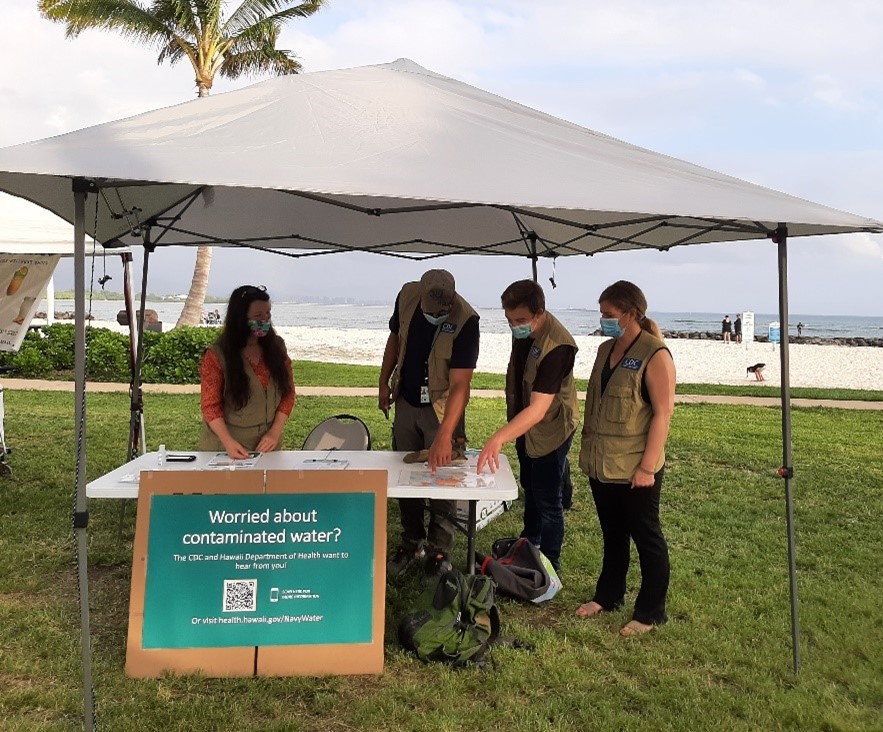Red Hill Response
Red Hill Response
On November 20, 2021, jet fuel leaked from the Red Hill underground fuel storage facility into the aquifer that supplies water to the Joint Base Pearl Harbor-Hickam Water Distribution System on Oahu, Hawaii. The water system serves approximately 9,700 civilian and military households. It also serves schools and workplaces.
The Hawaii Department of Health (HDOH) and Hawaii Poison Center began receiving hundreds of complaints from residents in the Pearl Harbor area. The complaints were about a fuel-like odor coming from their tap water. Subsequent water sampling found high levels of contamination with petroleum hydrocarbons. On November 30, 2021, the HDOH issued a drinking water advisory. Between February and March 2022, the advisory was amended and lifted on a zone-by-zone basis.
At the request of the HDOH, the Centers for Disease Control and Prevention (CDC) and Agency for Toxic Substances and Disease Registry (ATSDR) have supported the response in multiple areas. CDC and ATSDR have
- reviewed environmental sampling data,
- conducted a literature review and evaluation of potential long-term health effects of petroleum exposure through drinking water,
- assessed water system questions including treatment options and flushing risks,
- evaluated biomonitoring needs,
- deployed public health experts to investigate potential health impacts on affected civilian and military populations through three Assessments of Chemical Exposures (ACE) investigations, and
- started a public health assessment to evaluate whether exposures to chemical releases from the Red Hill facility since 2005 have harmed people’s health.

- ATSDR Community Stress Resource Center
- Initial ACE investigation survey results
- 2nd ACE investigation survey results
- Red Hill PHA Introductory Factsheet
- Hawaii Department of Health – Red Hill Resources
- Underground Storage Tanks Program | Red Hill Task Force and Fuel Tank Advisory Committee (FTAC) Meetings (hawaii.gov)
- Red Hill Public Engagement | US EPA
- U.S. Department of Veteran’s Affairs – Red Hill
- Defense Health Agency - Red Hill Information
- Joint Base Pearl-Harbor Hickam Water Updates (navy.mil)
- DOD’s Joint Task Force Red Hill
- Joint Base Pearl Harbor-Hickam Safe Waters
- CDC/ATSDR Toxicological Profile for JP-5, JP-8, and Jet A fuels
- CDC/ATSDR ToxFAQs JP-5, JP-8, and Jet A fuels
- Red Hill Bulk Fuel Storage Facility in Hawaii | US EPA
- Journal of Water & Health: Community-health-impacts-after-jet-fuel-leak
- MMWR: Notes from the Field: Self-Reported Health Symptoms Following Petroleum Contamination of a Drinking Water System — Oahu, Hawaii, November 2021–February 2022 | MMWR (cdc.gov)
- Hawaii Department of Health – Exposure Assessment: November 2021 Release of JP-5 Jet Fuel
- Defense Health Agency Webinar: Patient and Family Centered Care for Environmental Exposures: Red Hill Case Study
- ATSDR Community Stress Resource Center – Tips for Clinicians
- Hawaii Department of Health Medical Advisory – Drinking Water Petroleum Exposure
- Joint Base Pearl-Harbor Hickam Updates (navy.mil) – Medical